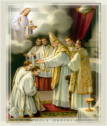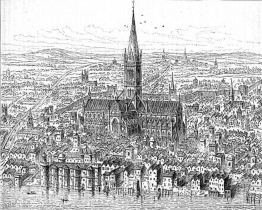





Docklands and the Thames,
Victoria Park to Paternoster
Square. Take a nostalgic
trip back to the East End in
the 1950’s or a stroll around
the Square Mile of the City
of London. It’s all here at
barryoneoff.co.uk
Copyright 2002 - 2024 ©Barry Carter. All rights reserved
Overview
Christianity came to Londinium during the first hundred years of it’s founding. Places of worship had existed but records can only be traced back to Saxon times. As Christianity spread, so did the number of churches. Before the 1666 fire there were around 133 parishes in the Square Mile. Each parish had a place of worship of which around 107 were recognised churches. Eighty five of these were destroyed in the blaze. Fifty one of the destroyed churches were to be designed and rebuilt by Sir Christopher Wren and his team, including Robert Hooke, Edward Woodroffe and later, Nicholas Hawksmoor. In order to keep costs down and speed up the building process Wren tried to use the existing foundations and any remaining structure. This explains the sometimes odd shapes of the buildings. The City was being built on the same street layout as before, and this often left little room for manoeuvre. As the Victorian age approached and transport, including the railway, became readily available people migrated from the Square Mile and the commuter age was born. This meant that the congregations dwindled and so parishes merged and churches were demolished. The Blitz of 1939-1945 caused as much damage as the 1666 fire had done. Hardly a church came out unscathed. Many were restored but others were gone forever.THE CHURCHES of the City of London (1)
St, Katherine Cree
Built in Leadenhall Street by the Prior of Holy Trinity, Aldgate, so that the Canons of the monastery would not be disturbed by the “laity”, or common parishioners. It was rebuilt in 1280, 1504 and 1628. It escaped damage by the fire and had only slight damage in the blitz. Sir Nicholas Throckmorton was buried here in 1571. The name Cree is thought to be derived from Christchurch. Purcell, Wesley and Handel have all played the Father Smith organ which dates from 1686, and was remade in 1866 and 1906.St. Andrew Undershaft
In Leadenhall Street in the shadow of the Gherkin. It’s original name was St. Andrew Cornhill and was first mentioned in 1147. It got it’s present name during the 15th. century when a maypole was erected next to the church each year. In 1517 on what is known as “Evil Mayday” the apprentices caused a riot and 300 were arrested, one of whom was hanged. The pole was then hung along the walls of the houses in Shaft Alley until 1549 when it was destroyed as a heathen idol on the orders of the curate of St. Katherine Cree. It is one of the few churches surviving both the fire of 1666 and the blitz, only to suffer damage from an IRA terrorist bomb in 1992. The tomb of John Stow is inside the church with his effigy sitting at a desk holding a quill pen. There is a ceremony performed here to change the quill every three years.




All Hallows On The Wall
This church is on the street named London Wall. In fact the vestry is actually built on one of the circular bastions of the original Roman wall. It was first mentioned in 1130. In 1474 a cell for anchorites was built. Simon the Anker was walled up in it for 20 years while writing “The Fruyt of Redemcyon” which was published by Wynken De Worde in 1514. Although it escaped damage in the 1666 fire it was rebuilt by George Dance the Younger in 1765-7. The pulpit is a strange feature. It is the only one in the City that has to be entered from outside the knave. WW II damage was restored by David Nye in 1960-62

St. Benet Pauls Wharf
Situated in Queen Victoria Street, this small Wren church occupies the site of the 12th. century building destroyed in the fire of 1666. It is named after Saint Benedict. The architect Inigo Jones was buried in the old church and there is a monument to him in the present one. Shakespeare gives a mention to the church in his play “Twelfth Night”. It came close to being demolished once again, in the 19th. Century until the Welsh Episcopalians acquired it and kept it in full use. This led to it being known as the "Welsh Church". Although attributed to Wren, there is strong opinion that it is Nicholas Hawksmoor's design. Sunday services are still held in Welsh language. The nearby College of Arms, also makes use of the church.

St. Andrew by the
Wardrobe
This unusual name was used from 1361 because it was once adjacent to the King’s Wardrobe where all the ceremonial robes were stored. Before this, from it’s first mention in 1244 it was known as St. Andre De Castello, because of the close proximity of Baynard’s Castle. The church was destroyed in the fire of 1666 and rebuilt by Wren in 1685-95. Despite WW II damage the red brick tower and walls are still the original Wren structure. When Queen Victoria Street was excavated in 1871 it exposed the church fully but also destroyed most of the churchyard. The rest was made a public garden in 1901. Three bells were brought here from Avenbury, Hertfordshire, in 1933 and one is said to have tolled unaided on the death of the Avenbury rector!St. Mary Le Bow
St. Mary Le Bow in Cheapside dates back to Norman times. It was destroyed by the fire of 1666 and while Wren was rebuilding it in 1670-80 he discovered the original 11th. century crypt and a Roman road beneath. It was again gutted by fire during the blitz on May 10th. 1941. It was restored to the original Wren plan in 1956-62 by Laurence King. It’s tower houses Bow Bells including “The great bell of Bow”, mentioned in the famous nursery rhyme “Oranges and Lemons”. Although the ringing was silenced for twenty years due to the WWII damage anyone born within the sound range of these bells was said to be a true cockney and the Pearly Kings and Queens still have a special service there annually. The bells were also used for over four hundred years to ring out the curfew from 1469 till 1876. The first record of the church dates from 1091 when the roof was blown off by strong winds. In 1271 twenty people were killed when the tower collapsed. A goldsmith called Duckett was murdered in the church in 1284 after seeking sanctuary there. This caused the hanging of sixteen men and the burning of a woman for taking part in the murder. The church was then closed until 1331 when it was consecrated again. The name is derived from the bow shaped arches inside the crypt and was originally called Mary D’ Arcubus by the Normans. The tower with it’s steeple is 66 metres high with a dragon weather vane which was once mounted by a stunt man called Jacob Hill. On the tower Wren incorporated a balcony. This was added as a historical reminder of the stone viewing platform built by Edward III in front of the church to watch pageants. An earlier wooden tower had been erected after the birth of the Black Prince, for Queen Isabella to watch the celebratory jousting tournament. Unfortunately the tower collapsed as soon as the ladies set foot on it. It was for this reason that the stone ‘shed’ was built. It remained up until the fire.


St. James Garlickhythe
Named after Saint James the Apostle, the church stands on Garlick Hill. It takes it’s name from the dock, or hythe, where the garlic was offloaded when it originally stood on the bank of the Thames in the middle ages. It was founded in the 12th. century and rebuilt in 1326. Like many other churches in the City, St. James’s was destroyed in the fire of 1666 and rebuilt by Wren from 1676-83 with the steeple following in 1713-17. It suffered some damage in the blitz but luckily a 500 pound bomb failed to explode after hitting. The damage was restored in 1954-63 and again in 1988 (clock). Unfortunately a crane managed to break a stained glass window and chandelier in 1991. The pews were also smashed. The window was replaced with plain glass and the pews with oak. The chandelier was recreated from the original drawings by the Glass Sellers Company.




St. Lawrence Jewry
The church stands in Gresham Street with its entrance in Guildhall Yard. Named after St. Lawrence, who was roasted to death on a grid iron in AD 258. The weather vane is in the shape of a grid iron, but some sources say that he was beheaded. The name Jewry comes from what used to be the Jewish section of the City until they were expelled in 1290 by Edward I. The nearby street, Old Jewry housed the Great London Synagogue until the expulsion Destroyed in the fire of 1666, it was rebuilt by Wren in 1671-77. After bombs in 1940 left only the walls and tower it was renovated by Cecil Brown in 1954-57
All Hallows By The Tower
Also known as All Hallows Barking. A Bishop of London, Eorconweald, founded an Abbey at Barking for his sister Ethelburga in 675. She and the nuns then went on to found this church. It stands in Byward Street near the Tower of London. Samuel Pepys the watched the Great Fire of London from the tower of the church in 1666. The green verdigris of the copper spire is quite spectacular. WW II bombs caused much damage but also uncovered some original Roman and Saxon remains which can be seen today. It has many historical associations. The famous Judge Jeffries was married here and rector Tubby Clayton made it the headquarters of the TOC H movement in 1922.


ABOVE
View of the City pre 1560
The central church is the old Saint Pauls
















